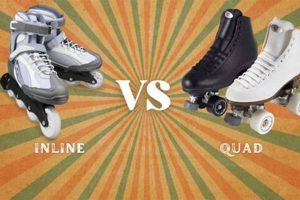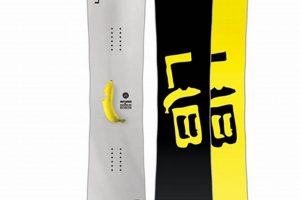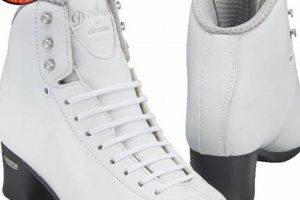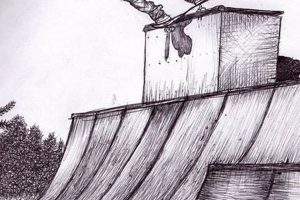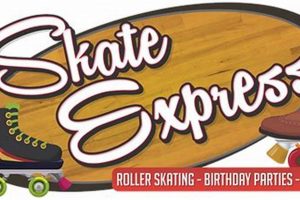The activity in question involves utilizing a raised, elongated architectural feature, typically constructed of concrete, for performing skateboarding tricks. This feature presents a flat surface along its top edge, allowing skateboarders to grind, slide, and perform various maneuvers. Common examples are found in skateparks and urban environments, integrated into benches, retaining walls, and other structural elements.
This form of skateboarding is crucial for developing technical skills, spatial awareness, and balance. Its popularity stems from its accessibility in urban landscapes, offering skaters diverse opportunities for creative expression. Historically, it evolved alongside street skateboarding, adapting architectural elements for trick execution.
The subsequent sections will delve into specific trick types, equipment considerations, safety protocols, and design innovations related to this particular facet of skateboarding.
Ledge Skate Tips
The following points offer guidance for those engaging in tricks on elevated surfaces within the skateboarding discipline. These recommendations prioritize safety, skill progression, and effective technique.
Tip 1: Begin with the Basics: Ensure a solid foundation in fundamental skateboarding maneuvers, such as ollies, before attempting tricks on ledges. A stable ollie is critical for clearing the edge and landing cleanly.
Tip 2: Start Small: Select lower ledges initially to develop comfort and control. Gradually increase the height as confidence and skill improve. This mitigates risk of injury during the learning process.
Tip 3: Approach with Proper Speed: Maintain a controlled speed that allows for sufficient time to execute the trick without overshooting the landing. Adjust speed based on the complexity of the intended maneuver.
Tip 4: Focus on Foot Placement: Precise foot placement is essential for maintaining balance during grinds and slides. Experiment with different foot positions to optimize stability and control.
Tip 5: Utilize Wax Effectively: Apply skate wax to the ledge surface to reduce friction and facilitate smoother grinds and slides. Consistent wax application is key, especially on rougher concrete.
Tip 6: Commit to the Trick: Hesitation often leads to failed attempts and increased risk of injury. Once committed, maintain focus and see the trick through. Confidence plays a vital role in success.
Tip 7: Wear Protective Gear: Helmets, knee pads, and elbow pads are essential for mitigating potential injuries. Prioritize personal safety by consistently utilizing appropriate protective equipment.
Tip 8: Practice Consistently: Consistent practice is fundamental for mastering ledge skateboarding. Regular repetition builds muscle memory and enhances overall skill level.
Adherence to these guidelines will promote safer and more effective skill development within this facet of skateboarding. Mastering fundamental techniques, combined with consistent practice and safety awareness, facilitates progression and reduces the likelihood of injury.
The subsequent sections will examine the evolution of trick variations, explore the impact of ledge design on performance, and consider the future of ledge skateboarding.
1. Trick Execution
Trick execution is a fundamental component of skateboarding on elevated surfaces, directly influencing both the feasibility and aesthetic quality of the activity. Successful execution is the intended result of a skater’s effort when using an elongated architectural feature for performing skateboarding tricks. Its importance arises from its causal relationship to skill development, physical safety, and the advancement of trick innovation within the discipline.
The ability to execute a trick, such as a boardslide or a grind, relies on a confluence of factors, including the skater’s balance, board control, and spatial awareness. For instance, a poorly executed 50-50 grind can result in a fall, while a properly executed one showcases both skill and control. Trick execution is not solely about completing a maneuver; it encompasses style, fluidity, and the ability to land cleanly. This influences a skater’s reputation and contributes to the overall progression of the sport. Competitions often judge based on the difficulty of the trick and how well it is executed. The level of mastery influences the progression and creativity on these features.
The understanding of trick execution’s integral role informs safety protocols, training regimens, and the design of skateparks. Recognizing the variables involved contributes to a holistic approach to skill development and risk management. The continuous striving for perfect trick execution pushes the boundaries of what is possible, furthering innovation and expanding the repertoire of tricks performed. A commitment to understanding and refining trick execution ensures both personal growth and the continued evolution of this style of skateboarding.
2. Surface Texture
The tactile quality of the material directly interfaces with the skateboard during grinding and sliding maneuvers. This attribute dictates the coefficient of friction, thereby significantly influencing trick feasibility and execution.
- Friction Coefficient
The inherent friction between the skateboard’s trucks or deck and the surface either facilitates or impedes sliding motion. A lower coefficient of friction, as found on polished concrete or metal, allows for longer, smoother slides. Conversely, a higher coefficient, characteristic of rough concrete, requires greater force to initiate and maintain a slide, potentially impacting trick execution.
- Material Composition
The constituent elements of the feature contribute to its overall texture. Concrete, the predominant material, can vary significantly in texture depending on aggregate size, finishing techniques, and weathering. Metal surfaces, such as steel coping, offer predictable smoothness, while painted or coated surfaces introduce additional variables, including paint adhesion and wear resistance.
- Surface Imperfections
Irregularities, cracks, and chips in the surface alter the contact area between the skateboard and the feature. These imperfections can introduce unpredictable friction, causing the skateboard to catch or veer off course. Maintaining a smooth, consistent surface is crucial for consistent trick performance. Regular maintenance, including patching cracks and removing debris, becomes essential.
- Wax Application
The deliberate application of paraffin wax is a common practice to modify the surface texture and reduce friction. Wax fills minor imperfections and creates a more uniform sliding surface. Proper wax application technique is critical; excessive wax can create a sticky residue, while insufficient wax provides minimal benefit.
These elements collectively define the interaction between the skateboard and the surface, thereby directly affecting the difficulty and predictability of tricks. The careful consideration and management of these textural factors is integral to maximizing performance and minimizing risk in this skateboarding discipline.
3. Obstacle Height
Obstacle height is a primary determinant of trick difficulty and risk within the specific skateboarding activity. The vertical dimension of the architectural feature significantly impacts the skater’s ability to initiate, execute, and land maneuvers. A lower height facilitates entry-level tricks, reducing the potential for severe injury. Conversely, greater heights introduce a higher degree of technical challenge and amplify the consequences of failed attempts. For example, a novice skater might begin with a ledge only inches from the ground, practicing basic slides. An experienced skater, however, may attempt complex grind combinations on ledges several feet high, requiring precise timing and board control.
The selection of an appropriate obstacle height is a crucial element of skill progression and risk management. Skaters typically advance incrementally, gradually increasing the vertical dimension as their competence grows. This approach mitigates the likelihood of injury and fosters a sense of confidence. Furthermore, obstacle height directly influences trick selection. Certain maneuvers, such as more complex flip tricks onto or off the feature, necessitate sufficient vertical clearance. The architectural design of skateparks incorporates variations in ledge height to accommodate skaters of differing skill levels, promoting accessibility and encouraging continued participation.
In summary, the height of the architectural feature plays a pivotal role in determining the difficulty, risk, and trick selection in this skateboarding discipline. An understanding of this relationship is essential for both skaters and skatepark designers, promoting safe skill development and fostering a dynamic environment for progression. The deliberate manipulation of obstacle height constitutes a key element of strategic design and risk mitigation.
4. Approach Speed
Approach speed significantly influences the outcome of skateboarding maneuvers on raised, elongated surfaces. This initial velocity determines the momentum available for executing tricks, impacting the skaters ability to clear the obstacle, maintain balance during the maneuver, and successfully land. Insufficient speed may result in the skater failing to reach the edge or losing momentum mid-trick, leading to an incomplete or failed attempt. Conversely, excessive speed can lead to overshooting the landing, increasing the risk of loss of control and potential injury. For example, when attempting a boardslide, a moderate and controlled speed is essential for gliding smoothly along the surface; too slow, and the board may catch; too fast, and the skater risks losing balance upon landing.
The relationship between approach speed and successful trick execution is further complicated by the surface material, obstacle height, and the skater’s technical proficiency. Rougher surfaces require greater speed to overcome friction, while higher obstacles demand precise speed control for clearing the distance. Experienced skaters often subtly adjust their approach speed based on these variables, demonstrating an intuitive understanding of physics and kinetic energy. In professional skateboarding, skaters routinely analyze the approach to an obstacle, calculating the optimal speed necessary to execute complex trick combinations. This calculated approach reflects the practical significance of understanding speed as a fundamental component.
In conclusion, approach speed is a critical variable directly affecting the success and safety of skateboarding maneuvers on ledges. The ability to accurately assess and manage speed, considering both the characteristics of the obstacle and the skaters capabilities, is fundamental to mastering this discipline. While the challenge of finding the optimal speed can be significant, understanding this aspect is essential for progression and injury prevention in skateboarding.
5. Foot Placement
Foot placement is a critical determinant of balance, control, and trick execution when skateboarding on ledges. Precise positioning of the feet on the skateboard deck directly influences the skater’s ability to manipulate the board during grinds, slides, and other maneuvers. Optimal placement ensures stability and facilitates the transfer of body weight, allowing for controlled movement along the ledge.
- Heel and Toe Positioning
The distribution of weight between the heels and toes affects the board’s responsiveness and stability. During a grind, a slight heel-side bias may help maintain balance, while a toe-side bias may be necessary for certain slide variations. Fine adjustments in heel and toe pressure are essential for correcting imbalances and maintaining control. For example, a skater performing a 50-50 grind may subtly shift weight toward the heels to prevent the board from slipping off the ledge.
- Stance Width and Angle
The width of the stance and the angle of the feet impact the skater’s stability and range of motion. A wider stance generally provides greater stability, particularly during landings. The angle of the feet can influence the skater’s ability to initiate and control rotations. A skater preparing for a frontside boardslide may adopt a slightly angled stance to facilitate the rotation, positioning the front foot closer to the board’s edge.
- Foot Position Relative to Trucks
The location of the feet in relation to the skateboard trucks dictates the leverage available for controlling the board. Placing the feet directly over the trucks maximizes stability, while positioning them slightly ahead or behind the trucks can enhance maneuverability. For instance, a skater executing a manual on a ledge needs to carefully position the feet over the back truck to lift the front wheels and maintain balance.
- Adjustments During Trick Execution
Foot placement is not static; skaters often make subtle adjustments during trick execution to maintain balance and control. Shifting weight or repositioning the feet slightly can compensate for uneven surfaces or unexpected movements. An experienced skater, encountering a rough patch on a ledge during a grind, will instinctively adjust foot placement to maintain balance and continue the trick.
In summary, foot placement is a dynamic and crucial element of skateboarding on ledges. Mastery of foot positioning techniques allows skaters to execute complex maneuvers with precision and control, minimizing the risk of falls and maximizing the potential for creative expression. Understanding the interplay between foot placement, board mechanics, and body positioning is essential for skaters seeking to progress their skills and expand their repertoire of tricks.
6. Body Positioning
Body positioning is a fundamental element in successfully executing skateboarding maneuvers on ledges. The skater’s posture, weight distribution, and orientation relative to the board and obstacle directly influence balance, control, and the ability to perform tricks effectively. Proper body positioning optimizes the transfer of momentum and mitigates the risk of falls, while incorrect positioning can lead to instability and failed attempts.
- Center of Gravity Alignment
Maintaining the skater’s center of gravity over the base of support provided by the skateboard is crucial for stability. During grinds and slides, skaters must adjust their body to compensate for shifts in momentum and maintain balance. For instance, when performing a 50-50 grind, leaning slightly into the ledge helps keep the center of gravity aligned, preventing the board from slipping off. Misalignment of the center of gravity often results in a loss of balance and a fall.
- Shoulder and Hip Orientation
The alignment of the shoulders and hips influences the skater’s ability to initiate rotations and maintain control during tricks. Correct orientation allows for smooth transitions and prevents the body from twisting excessively. When executing a boardslide, for example, rotating the shoulders and hips in the direction of the slide helps maintain balance and facilitates a clean exit. Improper shoulder and hip alignment can lead to awkward landings and increased risk of injury.
- Arm Placement and Balance
The position of the arms plays a significant role in maintaining balance and adjusting to changing conditions. Extending the arms outwards provides a wider base of support, while subtle arm movements can compensate for imbalances. A skater might use their arms to regain balance after a slight miscalculation during a trick. Controlling arm placement is essential for maintaining composure and avoiding unnecessary movements that could disrupt the skater’s equilibrium.
- Knee and Ankle Flexion
Flexing the knees and ankles allows the skater to absorb impact and maintain a low center of gravity, enhancing stability and control. This posture enables the skater to respond quickly to changes in terrain and execute subtle adjustments. During landings, bending the knees cushions the impact, reducing stress on the joints and preventing injuries. Consistent knee and ankle flexion is vital for maintaining a dynamic and responsive stance.
These interconnected elements of body positioning collectively contribute to the skater’s ability to navigate and manipulate the skateboard on ledges. Mastery of these techniques requires practice and a keen awareness of one’s body in relation to the board and obstacle. The effective application of these principles is essential for both executing basic maneuvers and pushing the boundaries of advanced trick performance. Adaptations and fine-tuning are necessary to navigate the features. Ultimately, understanding and applying optimal body positioning is a cornerstone of success in ledge skateboarding.
7. Board Control
Board control is paramount in the execution of skateboarding maneuvers on elevated surfaces. It is the skater’s capacity to precisely manipulate the skateboard, maintaining balance and direction while interacting with the architectural feature. Without proficient board control, even the most basic tricks become hazardous, hindering progression and increasing the risk of injury. Therefore, a thorough understanding of its component facets is critical.
- Weight Distribution and Balance
Effective board control relies heavily on the skater’s ability to distribute weight appropriately across the board. Subtle shifts in weight can influence the board’s trajectory and stability, particularly during grinds and slides. For example, maintaining a centered weight distribution is crucial for a stable 50-50 grind, whereas leaning slightly can initiate a boardslide. Imprecise weight distribution can lead to the board slipping off the ledge or an unbalanced landing.
- Edge Engagement and Disengagement
The ability to consciously engage and disengage the edges of the skateboard is fundamental for controlling its movement along the architectural feature. Engaging the edge allows the skater to lock into a grind or carve smoothly, while disengaging the edge facilitates transitions and exits. Mastering this skill requires precise foot placement and a sensitive understanding of the board’s response to pressure. An example of this technique is during a feeble grind, where the skater uses the front truck to lock onto the ledge, requiring controlled engagement to prevent slippage.
- Momentum Management
Maintaining and adjusting momentum is essential for successfully executing tricks. Board control facilitates the skater’s ability to convert, redirect, or even dissipate momentum as needed. This could mean generating extra speed for clearing a gap, or quickly decelerating after reaching the apex of an air trick. For instance, when performing a noseslide, the skater must control momentum to avoid over-rotating or losing balance.
- Directional Precision
The capacity to precisely control the direction of the skateboard, both laterally and rotationally, is another facet of proficient board control. Skilled skaters can initiate and maintain specific trajectories, whether grinding in a straight line or executing complex rotations. Accurate directional control is evident when a skater can confidently perform a kickflip onto the ledge, landing squarely and maintaining a stable position.
These elements of board control are interconnected and indispensable for navigating the challenges presented. Further exploration and refinement of these skills are vital for both safety and progression in this style of skateboarding.
Frequently Asked Questions
The following questions address common inquiries and misconceptions regarding the practice of skateboarding on raised, elongated surfaces. These answers aim to provide clarity and promote a deeper understanding of this skateboarding discipline.
Question 1: What constitutes “ledge skate?”
The term refers to skateboarding performed specifically on ledges, which are typically constructed from concrete. This activity involves tricks such as grinds, slides, and other maneuvers executed along the edge of the architectural feature. These features are prevalent in skateparks and urban landscapes.
Question 2: What fundamental skills are prerequisite for attempting tricks on ledges?
Proficiency in basic skateboarding maneuvers, such as the ollie, is essential. A stable ollie provides the necessary height and control for clearing the edge. Mastery of balance and board control is also critical before attempting more advanced tricks on ledges.
Question 3: What safety equipment is recommended for skateboarding on ledges?
Helmets, knee pads, and elbow pads are considered essential safety equipment. Wrist guards are also recommended. Consistent use of protective gear significantly reduces the risk of injuries during falls and impacts.
Question 4: How does surface texture affect trick execution on ledges?
The texture directly influences the coefficient of friction, affecting a skater’s ability to perform slides and grinds. Smoother surfaces reduce friction and facilitate smoother, longer slides. Conversely, rougher surfaces increase friction, requiring greater force and potentially hindering trick execution.
Question 5: What role does wax play in “ledge skate?”
Skate wax is applied to the ledge to reduce friction. It smooths the surface, enabling easier and more consistent grinds and slides. Regular wax application is especially important on rougher surfaces. The proper application of skate wax can significantly influence trick performance.
Question 6: How does approach speed impact trick success on ledges?
Approach speed dictates the momentum available for executing a trick. Insufficient speed can lead to incomplete or failed attempts, while excessive speed can result in overshooting the landing. A controlled and appropriate speed is critical for maintaining balance and successfully performing the desired maneuver.
These questions and answers serve to address common areas of inquiry, promoting safer practices, and a greater understanding of the nuances involved. Further exploration of these concepts will enhance overall skill development and appreciation for the complexities of this skateboarding activity.
The next section will cover the impact of skatepark design.
Conclusion
The preceding exploration of this aspect of skateboarding has highlighted the intricate interplay of technical skill, environmental factors, and strategic planning required for successful execution. The importance of balance, board control, and precise foot placement has been underscored, as has the influence of surface texture, obstacle height, and approach speed. Mastery of these elements is crucial for progression and injury prevention.
As this discipline continues to evolve, continued innovation in both technique and equipment will undoubtedly reshape its landscape. Further research and development in skatepark design, safety protocols, and skill development methodologies will serve to enhance the experience for skaters of all levels. A deeper understanding of the principles outlined herein will ensure continued growth, creativity, and safe progression within the skating community.


